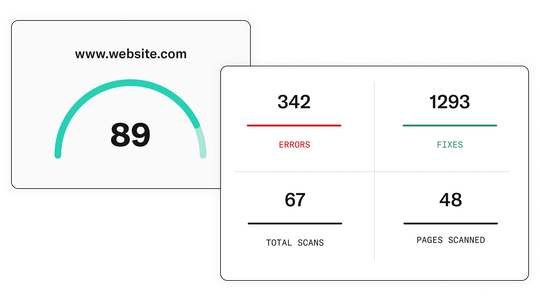61 Million Adults in the US live with a Disability
If your website isn’t accessible to individuals with disabilities, your business could be seen as “not inclusive”. If that wasn’t bad enough, you are also exposing your company to expensive & time-consuming legal action for something you probably didn’t know you needed.
Business owners are familiar with the Americans with Disabilities Act of 1990 or ADA, which …” prohibits discrimination against individuals with disabilities in all areas of public life, including all places that are open to the general public.”
What you may not know is that in 2018 the Department of Justice affirmed that websites are places of public accommodations and must comply with the ADA. This was validated by the Supreme Court in October 2019, when they ruled “…the Americans With Disabilities Act protects access not just to brick-and-mortar public accommodations, but also to the websites and apps of those businesses.”
Position your brand as one that is socially conscious and inclusive
Reach a larger audience
Reduce your exposure to an ADA-related lawsuit
Potential tax benefits

Are Businesses Legally Required to Make Their Websites Accessible?
This is being decided in courts across the country. Since the 2019 Supreme Court ruling, tens of thousands of demand letters have been issued to businesses for website ADA violations. There has also been a 400% rise in the number of digital accessibility lawsuits filed and lost in U.S. Federal Courts, since 2018. Read more & see examples here.

Is Your Website Currently Accessible?
We hope so….but the reality is that it probably isn’t. A recent survey concluded that 98% of U.S.-based websites are not accessible to the disabled community. To find out your current accessibility score, we only need your URL and e-mail address. Your report will show the number of issues on your site, and your accessibility score AFTER we install the compliance toolbar.
What do Businesses Need to do to be Accessible or Compliant?
To reduce your exposure to a digital accessibility lawsuit, you need to show that you have made reasonable efforts to make your digital content accessible to everyone. Individuals living with disabilities use screen reading & content converting tools to use the internet, our toolbars ensure your site works with these tools.
To further reduce your legal exposure your website needs to comply with WCAG 2.0 A & AA and Section 508 guidelines.
Finally, you should also have an Accessibility Policy & Statement on your website.
FREE ACCESSIBILITY SCAN
We provide a summary report that shows the pages scanned and the number of Accessibility & Compliance errors found.
We provide this at no charge to you, just complete the form and we will send you the report, usually on the same day.
FULL AUDIT SERVICES
We provide 2 levels of audit services.
- AI-powered automated scan which detects +80% of all issues
- We also offer an AI scan with a human audit which detects 100% of all issues
Pricing depends on the number of pages you want us to audit…contact us to see an example Audit or for a free quote.
Accessibility Toolbar
Get Started- AI-powered toolbar makes your website accessible
- Putting forth a reasonable effort to make your content available to individuals with disabilities
- Doesn’t fix the issues with your site – which is required for compliance
Compliance Toolbar
Immediate Compliance- AI-powered toolbar makes your site accessible
- Fixes most compliance issues (+80%). Sits between the web server and the users’ browser.
- Your site becomes mostly compliant TODAY, and you can work on a plan to address additional issues that are uncovered during audit
- Compliance statement for your site
Compliance + Remediation
Fix Underlying Issues- Compliance toolbar +
- All issues discovered during audit are fixed (by us or your developers)
- Compliance statement for your site
- Legal support if you receive a demand letter
Compliance + Certification
100% Compliance Guarantee- Compliance toolbar +
- Remediation (we fix all issues)
- Daily scans, new compliance violations are fixed instantly
- Compliance statement for your site
- Advanced Legal support if you receive a demand letter or if you are currently facing legal actions
- Perfect for large sites with e-commerce, PDF, and Video files
Potential Tax Benefits of Website Accessibility & ADA Compliance
Small businesses incur costs when they modify their physical locations. Tax benefits/credits have been established to help offset these expenses. These same tax credits apply to website accessibility expenses.
Tax Credit Details
To claim tax benefits for website accessibility and compliance expenses, use IRS Form 8826, the Disabled Access Credit, and refer to Title 26, Internal Revenue Code, Section 44.
The Disabled Access Credit is limited to small businesses with gross receipts of one million dollars or less or that employ 30 or fewer people.
- Example 1: Your company spends $5,000 on an accessibility audit or enhancing your website’s accessibility.
Only expenditures above $250 qualify, so subtract $250 from $5,000 to get $4,750.
You can claim 50% of that amount as a tax credit. In other words, you can subtract $2,375 from the tax owed on your next return. - Example 2: Your company spends $12,000 on an accessibility audit or enhancing your website’s accessibility.
You have exceeded the limit of $10,250.
You can claim $10,000 of that. The 50% tax credit, then, comes out to $5,000.
Note also that the same expenditures cannot be capitalized, cannot be used in figuring a different credit. Also note, however, that this is not a one-time credit. It can be used each year as long as eligibility requirements are met.
State Taxes
The Disabled Access Credit applies to federal taxes. There may also be additional tax benefits at the state level. You should consult a tax professional or perform additional research, depending on the state where your business is based.
For more information, see the IRS Tax Credits and Deductions page on the Americans with Disabilities Act website.
Net Clicks Marketing is not responsible for any tax information that changes or is misinterpreted. This is meant to be informative and does not replace the advice of an accountant or tax professional.
Get a Free Accessibility Scan or a Custom Quote
Why Does Web Accessibility Matter?
VISUAL
Blindness
Low Vision
Color Blindness
AUDITORY
Deafness
Hearing Impairment
MOTOR
Difficulty Using Hands
Limited Fine Motor Control
Muscle Slowness
Tremors and Spasms
COGNITIVE
Learning Disabilities
Memory Impairments
Attention Disorders
Problem Solving and Logic
FAQ's
- Title III of the ADA references “places of public accommodation” and makes no exemptions for small businesses. Plaintiffs are claiming Title III violations in their digital accessibility lawsuits.
Are small businesses really being sued for website accessibility?
- Yes, individual lawsuits tend to focus on a single business, however, many class actions have been filed and the firms organizing them are including businesses of all sizes and industries.
What could being served a demand letter mean to your business?
- If you are sued you will have to pay a lawyer, pay a fine (typically $3,000 PER ISSUE DISCOVERED on your site) AND you will have to agree to fix your site.
Are there SEO benefits from being ADA compliant?
- YES, ADA compliance includes adding descriptive tags to every piece of visual and audio content. This makes it easier for Search Engine Algorithms to interpret your content and will result in better placement in search results.
Is using an accessibility widget all you need to do in order to make your site accessible and limit your legal exposure?
- Accessibility widgets make most of your content available to most users with disabilities.
- Compliance widgets further address accessibility issues by sitting between the code that makes your website/app and the user’s browser. Your code is temporarily changed to fix accessibility issues.
- An AI audit with Human testing and remediation is the only way to be 100% confident all issues have been fixed.
Is making your website compliant expensive? How much does it cost?
- It can be if you don’t have a plan.
- We have plans for small websites that start at $49 monthly, so a year of accessibility can cost less than an hour of legal fees.
- Your expense depends on how much content you have, how much you want to limit your exposure to legal action and how much accessibility you want to add.
Accessibility is the practice of making your websites usable by as many people as possible. This includes individuals with visual, audible, and cognitive disabilities…Read More
%




